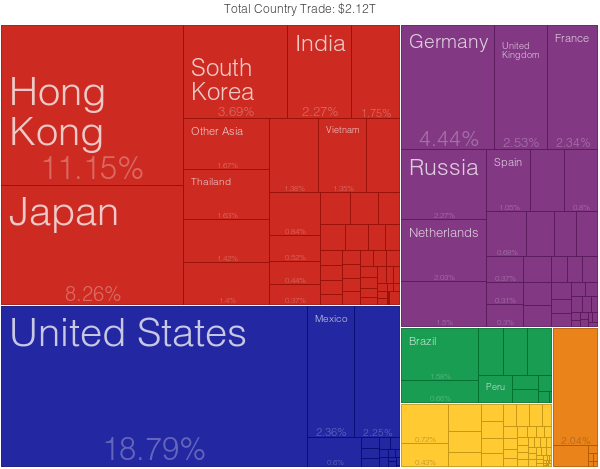Monday’s released HSBC China PMI (Purchasing Managers Index) for January disappoints, coming in at a seasonally adjusted 49.7 (with anything below 50 signalling contraction in the Chinese factory sector). The unexpected contraction is the first in nearly 2½ years and a low not seen since September. It is also slightly lower than Sunday’s preliminary “flash” reading of 49.8.
The PMI is a reflection of exports and domestic demand. Since the US experienced a wider trade deficit and a strengthening dollar, and the Japanese yen also strengthened, the decrease in exports is likely being caused by European uncertainty (fuelled now by Greek filibustering), Russia’s tumble (due to the decrease in oil prices and Ukraine-related sanctions) and overall global malaise.

Importers of Chinese goods (Source: Observatory of Economic Complexity)
Domestic demand, on the other hand, is suffering from conservative Chinese monetary policy, but this latest disappointing gauge is raising questions about whether China will accelerate their monetary policy easing (with many economists calling for a combination of both rate cuts and increased Liquidity ).
Asian shares have all been winded by the news. MSCI’s AC Asia-Pacific Index fell by around 0.06 percent, the Nikkei was down 0.66 percent on the news and the Shanghai Composite dropped by 2.56 percent.
Market strategists are also expecting European bourses to take a hit, with Britain’s FTSE 100, Germany’s DAX and France’s CAC 40 all opening lower on the news (by as much as 0.1 percent, 0.3 percent and 0.1 percent respectively).
Since the release of the US fourth-quarter domestic report on Friday, Wall Street hasn't been doing too well either. According to the report, growth slowed sharply due to weak business spending and the aforementioned trade deficit.
On Friday, major US stock indices posted losses for the month, with the S&P 500 falling 3.1 percent in January, the largest monthly dip in a year.
Market participants are watching these two economies closely. With China being the world’s second largest economy, any under-performance now from the US could cut down investor confidence.
CNYUSD
China’s yuan has fallen to an eight-month low against the US dollar. It’s been on a downward trend as Beijing attempts to spur growth via monetary policy. With a weaker currency, exports should increase and inflation should soften.
Although the US dollar index tumbled by 0.1 percent on the release of the fourth-quarter report on Friday, overall it has still experienced its seventh straight advance in January (actually marking the longest streak of monthly gains since the dollar was floated in 1971). The long-term outlook remains positive as the US Federal Reserve is expected to begin raising interest rates later this year.
















